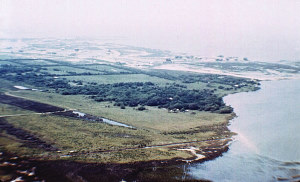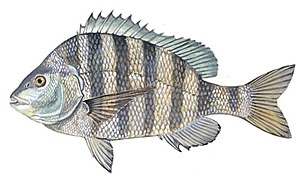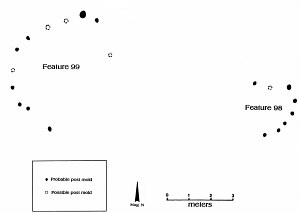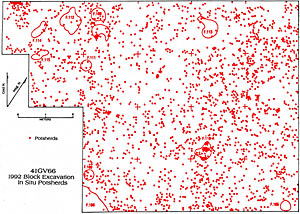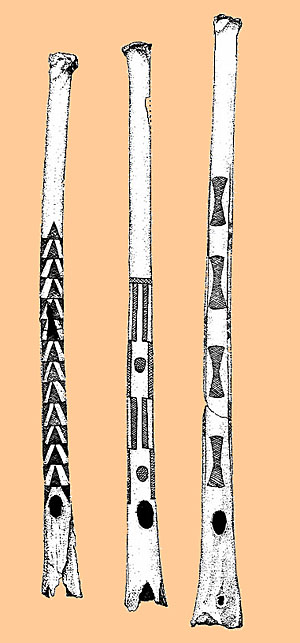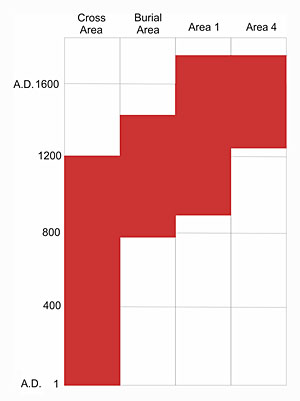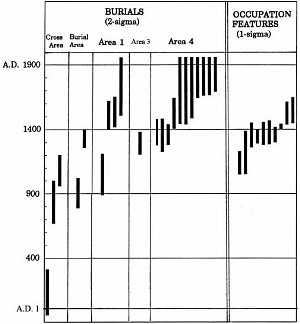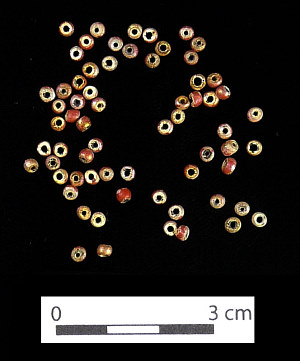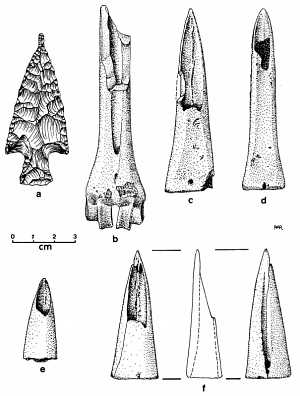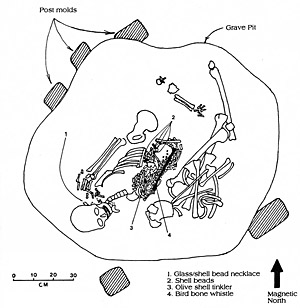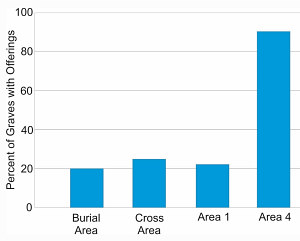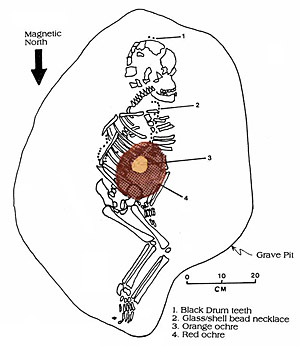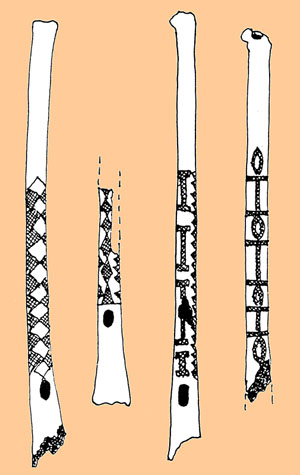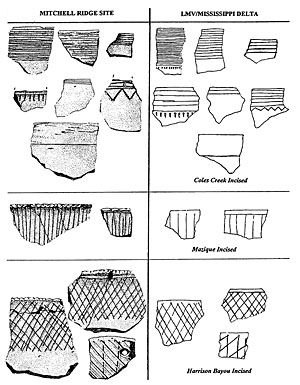Life and Death at Mitchell Ridge
|
Archeological evidence for life and death at Mitchell tells a fascinating, multi-layered story, much of which as been detailed in the other sections of the exhibit. Here we try to bring the story together focusing more on the evidence from the cemetery areas than that of the occupation areas for two reasons. The 1992 investigations and the 1994 report concentrated on the latter. And, as we see it, a lot more was learned that we did not already know about aboriginal life along the upper Texas coast by studying graves and human bones than from looking at the ordinary leavings of daily life. Nonetheless, the occupational evidence is revealing. Barrier Island Life Our interpretation is that over a span of at least eight centuries Mitchell Ridge served as a traditional cool-season shoreline camp of the sort the Spanish would have referred to as a "rancheria" or temporary village. From this base those who camped there would have ventured forth on the island, in the bay, and sometimes across the bay to fish, gathered roots and other plants, hunt deer, trap rats, and seek other natural resources that sustained life. Abundant occupational evidence demonstrates the use of the site during the Late Prehistoric period, A.D. 700-1500. We have little doubt that the site area was also occupied during the Protohistoric and Early Historic periods as well and probably during the the latter part of the Early Ceramic period. Our best guess is that peoples returned to the site on and off for as long as 1700 years. . Seasonal estimates from fish otoliths (inner ear bones) suggest that the site was occupied mainly in the cool-season during the fall and winter months. The upper coast Indians with whom Cabeza de Vaca lived for several years also overwintered on a barrier island (possibly Galveston Island), suggesting this was a common upper coast pattern. From March to September, de Vaca's group lived on the mainland around the upper bays and inland, returning to the island in October. While on the island, Cabeza de Vaca says people caught many fish in the late fall and relied mainly on roots during the winter. Mitchell Ridge yielded no direct evidence of root consumption, but roots were almost certainly important to the island economy. The site did yield abundant fish and animal bones. These tell us that primary source of meat was fish, followed by white-tailed deer and hispid cotton rats. Rats are thought to have been the dominate mammal on the island and were probably trapped. Most of the deer, on the other hand, were probably hunted on the mainland, given that early historic accounts state that there few large mammals on Galveston Island. This raises an important point. Barrier island life depended on water transportation to and from the mainland. Historical accounts indicate that it was possible during particularly low tides to wade across West Bay along Karankawa Reef, a few miles down the island from Mitchell Ridge, this would have been a challenging route for those laden with supplies, children, and the infirm. We infer that they must have also used dugout canoes like those mentioned in early historic accounts. The hundreds of deer bones found at the site suggest that hunting parties periodically left and returned to the island. Gar scales were common at Mitchell Ridge and while gar can tolerate brackish water, they are rarely found in marine water, meaning that these too must have been obtained off the island in the upper bays or inland waterways. Fish were clearly a mainstay as suggested by de Vaca and shown by the preponderance of fish bones at Mitchell Ridge. There were five types of saltwater fish present in the assemblage: hardhead catfish, black drum, sheepshead, redfish, and seatrout. We infer that they used several different fishing techniques including shooting, netting, and trapping. The evidence for netting includes perforated oysters thought to have been net weights and rectangular shaped bone objects similar to tools used by net makers to insure even spacing. Large numbers of hardhead catfish bones also imply netting. These are relatively small fish that would have been difficult to catch in any other way short of small hooks, of which none were found. Cabeza de Vaca mentions "canales" which has been translated as fishing weirs. No archaeological evidence of this technology is known from Texas, but this is not surprising. Early historic accounts from the east and west coasts of North America suggest that weir use was widespread. Weirs are typically formed of closely spaced wooden stakes arranged in V-shaped patterns to direct fish toward traps, nets, or men wielding spears or arrows. Cabeza de Vaca described his upper coast captors as being "extremely skilled" with the bow and arrow. Relatively large fish such as black and red drum and sheepshead would have been easy prey in confined shallow water. Simple dwellings were constructed such as the mat-covered brush huts mentioned by de Vaca. Three arcing patterns of postholes documented at Mitchell Ridge appear to represent such huts. One had a central hearth within it and it is likely that other hearths found at the site would have been associated with dwellings. Several hearths were lined with oyster shells and/or potsherds, probably to insulate the fires from damp sand. Cabeza de Vaca mentions that wood was hard to find, which is consistent with the observation that all of the hearths and burned patches were small in size. We do not know how often Mitchell Ridge the was used, and we suspect that many of the other sandy ridges along Galveston Island were periodically used as cool-season camping areas. We can, however, point out that fragments representing about 450 pottery vessels were recovered from a relatively small sample of the Mitchell Ridge site. In other words, thousands of pots used for storage and cooking were broken at the site, suggesting the site was heavily used at times. Similarly, we do not have a good basis to estimate how many people would have camped at Mitchell Ridge. The area with concentrated occupational debris ran some 250 meters along the ridge 70-120 meters wide. In other words, the occupation area would have exceeded two football fields end to end. This would have easily accommodated the fall-winter population aggregates of 100-400 that Aten reconstructed for historic Akokisa groups. What the Mitchell Ridge Cemeteries Tell Us The information gleaned from the 32 documented graves, containing remains of at least 51 individuals, provides archaeologists with a unique set of insights into some of the fundamental aspects of aboriginal society and belief. The mortuary data also speak to the population dynamics of indigenous populations of the upper Texas coast. These insights are of a quite different order from the things that are learned from the study of the camp debris that archaeologists generally work with. Mitchell Ridge Cemetery Timeline The four aboriginal cemeteries that were investigated at Mitchell Ridge span some seventeen centuries, based on radiocarbon dating of small samples of human bone. Radiocarbon “dates” are, of course, actually statistical probability estimates (assays) that can be expressed in different ways. Here we summarize the radiocarbon evidence by presenting the dates as calibrated two-sigma ranges (the statistical margin of error within which the true date has a 95% chance of falling), rounded to the nearest decade. We then narrow down these statistical spans using overlapping central tendencies and other factors such as the nature of the associated grave goods, some of which we have independent means of estimating their age. For instance, glass trade beads can date no earlier than the 16th century, and most of those found at the site were brought to North America in the 17th and 18th centuries. By judiciously combining this information we gain confidence in the timeline. The earliest Mitchell Ridge cemetery is the Cross Area, in which five graves containing the bones from seven individuals were documented in the 1970s, three of which were dated. The oldest burial from the entire site is Burial 10, with a radiocarbon age range of between 50 B.C. and 310 A.D. This burial was associated with a Godley dart point, which is consistent with the radiocarbon estimate. Both other dated burials from the Cross Area cemetery are considerably later. The radiocarbon age range for Burial 12 is between A.D. 770-1000, while that for Burial 7 is A.D. 1000-1200. Taken together, the Cross Cemetery began to form in the Early Ceramic period, but there may have been a 500-year gap before continued in use during the Initial Late Prehistoric period. This gives as a total span of as long as 1250 years. The next oldest cemetery is the Burial Area investigated during the 1970s. This small cluster of five graves contained a total of six individuals, two of which were dated. The radiocarbon range for Burial 4 is between A.D. 780 and 1000, while that of Burial 3 is 1270 to 1400. Taken together, the Burial Area cemetery was used in the Initial Late Prehistoric and Final Late Prehistoric periods, a span of as long as 620 years. The site’s only isolated grave that was clearly not part of a cemetery was the Feature 52 burial in Area 3. A radiocarbon date range of A.D. 1220-1390 for this burial suggests it most likely dates to end of the Initial Late Prehistoric period. The cemetery designated as Area 1 was investigated by archaeologists in 1992, and was a discrete cluster of 10 burial pits containing 13 individuals, four of which were dated. (The Area 1 cemetery was encountered unexpectedly by construction and the partial bones of at least five other individuals were recovered from disturbed contexts.) Burial Feature 25 dated to A.D. 790-1210, while the three other burials had radiocarbon ranges that overlapped between A.D. 1530-1630, with the full range for all three being A.D. 1400-1950. The last century of the error estimate can be ruled out, thus the maximum span of the Area 1 cemetery is about 450 years. Few grave offerings accompanied the Area 1 interments, but an incised whooping crane ulna whistle from Feature 28 likely predates the Early Historic era. Taken together, the Area 1 cemetery was used in Initial and Final Late Prehistoric periods, although we cannot rule out the possibility that the Feature 92-2 burial occurred during the Protohistoric era. The latest, largest, best dated, and most thoroughly documented Mitchell Ridge burial ground is the Area 4 cemetery, which contained 11 grave pits within which were the remains of at least 24 individuals. This cemetery is the site’s most extraordinary and most informative by many measures, including 11 radiocarbon assays and a diverse set of of grave goods from which we can draw age inferences. The full range of radiocarbon assay estimates on bone samples from 11 individual graves is between 1280 A.D. and 1950 A.D. Once again the last century of the error estimate can be ruled out, leaving a maximum use span of 580 years. The Area 1 cemetery was likely first used during the Final Late Prehistoric period and used repeatedly during the Protohistoric and Early Historic periods as also attested by the presence of numerous glass artifacts and several of metal. These grave offerings show that the cemetery continued to be used until the middle of the 18th century. In summary, we can see that these four small cemeteries represent the entire span of Native American occupation of the Mitchell Ridge site, beginning in the first centuries A.D. The site and its cemeteries were in use during the later part of the Early Ceramic period, continuing throughout the Late Prehistoric and Protohistoric periods, and finally ended during the period of European exploration and initial settlement of the region the Eighteenth Century. This is a rather remarkable total span of perhaps 1600-1700 years. Each cemetery was used for several hundred years, meaning that the native peoples who camped at Mitchell Ridge must have regarded the site as a recognized home base that evoked strong feelings of ancestry and cultural tradition. Mortuary Traditions We think there are two distinct burial traditions represented by the site's graves. Burial 10 in the Cross Area cemetery stands out from all the other graves for several reasons. Firstly, it dates at least 500 years earlier than any other grave at Mitchell Ridge. Secondly, its array of grave offerings including stone dart points, bone points, and other items discussed in the Mortuary Patterns section are unique among the site's burials. Thirdly, unlike all other prehistoric burials at Mitchell Ridge, Burial 10 was laid out in an extended burial position with its head oriented to the northeast. In contrast, the Late Prehistoric burials have flexed body positions with the heads oriented to the west to south. As discussed in some detail in Chapter 8 of the site report, the various attributes of Burial 10 have close parallels with Late Archaic burials known from other sites in the central and upper Texas coast. Therefore, Burial 10 is associated with the Late Archaic mortuary tradition common to the region. This individual may not represent an ancestor of the peoples responsible for the later graves. We see all other burials at Mitchell Ridge as representing a single mortuary tradition that shares most elements of the Galveston Bay area tradition described by Lawrence Aten in 1976. The salient shared features include primary flexed or semi-flexed interments as the primary mode of burial; groupings of interments in small discrete cemeteries located near habitation areas; offerings with less than half of the burials, mainly of personal adornment, most commonly shell beads; red ochre in some graves; and patterned headward orientation reflecting a shared religious belief. There are, however, a number of meaningful differences as well that set Mitchell Ridge apart. Two of these are further discussed under "social organization." Namely, the frequency of grave offerings seems to increase through time and evidence that a social group interred at Mitchell Ridge had some sort of special ranking. In contrast, Aten thought that, for the Galveston Bay area, grave offerings had decreased through time and argued that the mortuary tradition reflected a egalitarian society in which few individuals got special treatment. Now we summarize other key differences between Mitchell Ridge and the previously known Galveston Bay area mortuary patterns. Aten detected a shift through time in headward orientation from predominately eastward to westward. At Mitchell Ridge, aside from a single very young child whose head was oriented to the northeast, all Late Prehistoric through Early Historic burials at are oriented to the west, most to the southwest. Aten also found multiple burials to be rare, whereas seven graves held more than one individual at Mitchell Ridge. Another mortuary aspect that seems to set Mitchell Ridge apart from other Galveston Bay area cemeteries is the occurrence of numerous examples of secondary burials in which the deceased had not been placed in the grave while the body was intact. In other words, the person had either died elsewhere and the bones brought to Mitchell Ridge or else the person had died earlier and the bones were later interred. There were five secondary cremations, meaning the bodied or bones had been cremated elsewhere and the charred remains were deposited in the graves (as opposed to primary cremations that occurred at the grave). There were also five uncremated secondary interments including one in which the bones bore cutmarks suggesting that the skeletons had been purposefully defleshed. A remarkable instance of multiple secondary burial is that of Feature 63, an Early Historic grave ringed by square-hewn posts. As detailed in the Mortuary Patterns section, this grave was first used for a primary semi-flexed burial. Later, the grave pit was reopened, the bones partially pushed aside and a rectangular burial bundle was interred that contained the remains of four individuals. Included were the disarticulated skeletons of two children and the highly fragmented burned bones of at least one adult and one subadult. This likely represents individuals who died elsewhere, perhaps on the mainland, and were brought to Mitchell Ridge for burial. The last category of secondary burials at the site is one that has not been recognized elsewhere in the Galveston Bay area, namely that of "token" burials. Seven individuals at Mitchell Ridge are represented by one or a few skeletal elements, most by bones from the hands and wrist or patellae (knee caps). These are clearly intentional interments. Six of the seven were juveniles. We speculate that the bones of these children represent tokens that physically and symbolically linked the deceased with family members buried at Mitchell Ridge. Social Organization Generally, anthropologists and archaeologists approach the study of hunter gatherers with the working assumption that such peoples lived in societies that were “egalitarian”, meaning that every individual was born more or less equal in status, power, and authority. The basic idea is that, before people settled into permanent towns and practiced some form of agricultural food production, they did not have inherited status/power, centralized political leaders, or an economic elite class. Therefore, it is generally assumed that there was little if any hierarchical ranking within society, and everyone shared a more or less equal status. Important decisions were made by consensus of either the entire group, or by individuals who were recognized as leaders by virtue of their innate personal abilities. Power and authority, if invested in any particular individual or subset of individuals within society, were achieved by merit and age status, rather than inherited by elite kin groups. Such a general model of hunter-gatherer society seems to be supported by ethnographic studies of the isolated groups of hunter-gatherers that have survived into modern times in relatively remote regions of the world. The findings in the Mitchell Ridge cemeteries are unexpected in light of these basic assumptions. If the aboriginal society had been basically egalitarian, it should have been the case that each of the interred individuals received essentially the same treatment upon his or her death. The amount of goods buried with the person, and the quality and value of those goods, should have been more or less equal in each instance, allowing for some differences in age, gender, and earned rank. In contrast, it is well known that graves of elite persons in hierarchically ranked societies in eastern North America contain more numerous and more finely made material goods than do graves of common folk. It is surprising, then, that the evidence at Mitchell Ridge does not show equal treatment of the dead, but rather indicates that a minority of the dead were buried with a markedly greater amount of material wealth than were the rest of the population. (Here we exclude Burial 10, which we have argued is part of an older Late Archaic mortuary tradition.) The Mitchell Ridge burials with the most grave goods were consistently found in one of the four cemeteries, Area 4, which suggests that it was this cemetery that was reserved for the interment of those members of the aboriginal society with relatively high social status. In the three other cemeteries, one-fourth or less of the graves contained any sort of inclusive offering. In the Cross Area, the Burial Area, and Area 1, the percentages of graves containing offerings in the forms of grave goods were a nearly identical minority, at 25, 20 and 22 percent, respectively. In stark contrast, 90 percent of the graves in Area 4 contained grave goods. Added to this is the fact that the range of items found in the four cemeteries showed a parallel contrast. In the Cross Area, the Burial Area and Area 1 cemeteries, the total number of different classes of grave goods was two, one and three, respectively. The classes included shell beads, stone projectile points, and a bird-bone whistle. Once again, Area 4 presented a strikingly different situation, with a total of 24 classes of goods in the graves, including such diverse objects as shell-bead necklaces and bracelets, whistles made from the wing bones of whooping cranes, chipped stone tools of various kinds, bone tools, bone beads, antler flaking tools, probable blood-letting tools used in curing rituals, freshwater mussel-shell ornaments, olive-shell “tinklers”, masses of ochre paint, and in burials of the Colonial period, glass bead necklaces, iron tools, a small brass bell, and a glass mirror fragment. What is probably most telling in all this is the fact that this diversity of material wealth was not randomly distributed amongst all the cemeteries, but was clearly restricted only to the Area 4 cemetery, indicating that this location was reserved for burial of those members of aboriginal society to whom was accorded preferential treatment in death, a pattern that presumably reflects at least a somewhat higher status during their lifetimes. While the social significance of these factors is open to different interpretations, it is clear that some degree of status distinctions were made. Further, it is apparent that this distinction was one of social differentiation, and not simply a trend through time, since despite considerable temporal overlap in the periods of use of the four cemeteries, the discrepancies in quantities and ranges of grave goods appear to be largely according to spatial segregation of the relatively high-status burials in Area 4. In sum, then, the findings at Mitchell Ridge strongly suggest that aboriginal social organization was not strictly egalitarian, but rather that there was some degree of social ranking that operated from at least Late Prehistoric times into the period of European contact. Further, it can be noted that a secondary pattern of differentiation in mortuary status was along the lines of age and sex. Cross-cutting the differentiation observed between the various spatially defined cemeteries is the fact that, generally, adult males were more likely to be provided with more material wealth than were children, and that, in turn, children received more than did adult females. Therefore, following the line of reasoning that the quantities of goods buried with individuals reflected their social status, men were in general according higher status than women and children, and children had higher status than did women. Calamitous Effects of Old World Diseases In the second half of the 20th century, anthropologists and historians came to understand that the extent of devastation of Native American populations caused by diseases introduced by European and Euroamerican explorers and colonists was far greater than had originally been thought. The estimates of pre-Columbian American Indian populations put forth in the early decades of the century came to be seen as far too low, and it was realized that these early calculations were based on 17th and 18th century historical population sizes that already had been decimated by decades of exposure to European-introduced diseases and resultant population loss. American Indians had had virtually no contact with Old World peoples prior to the voyages of Christopher Columbus, apart from tangential and isolated contact between Inuit and certain other Indian groups in the extreme northeastern part of the continent. Because of thousands of years of isolation between Old and New World populations, American Indians had developed no biological immunity to diseases such as smallpox and measles, which were absent from pre-Columbian America. Thus, Native populations were extremely vulnerable to the effects of these diseases, and even exposure to the common cold could, for them, be lethal. Historical research has shown that mortality rates among Indian tribes during specific epidemics were often as high as 50 percent or more. And it is clearly the case that some disastrous epidemics spread far beyond the locations of initial Euro-Indian contacts and far from European explorer sight or knowledge. The bioarcheological evidence from the Mitchell Ridge burials indicates a significant increase in mortality among the Native population during the Protohistoric and Historic Periods. This is reflected in the average number of individuals buried in a single grave during the Late Prehistoric (pre-European Contact), Protohistoric and Early Historic (Colonial) periods. Inferentially, an increasing number of persons buried in a single grave indicates an increase in deaths in the group that owned and used a given cemetery. For the Late Prehistoric period, the average number of individuals per grave pit is 1.2. In the Protohistoric Period, ca. A.D. 1500-1700, this increased to 1.5 persons per grave, whereas during the Early Historic (1700s), the average number increased around threefold over the Late Prehistoric, to 3.5 individuals per grave pit. These data suggest that the Native people of the upper Texas coast region were suffering the calamitous effects of European-introduced diseases even during the Protohistoric, a period during which there was minimal contact between Indians and Europeans. By the Eighteenth century, with more face-to-face interactions between natives and French traders and Spanish colonists, the demographic impacts wrought by epidemics were even more dramatic. In the end demographic collapse signaled the demise of so many native groups like those for whom Mitchell Ridge was a traditional campsite and burial ground. Who Were the Mitchell Ridge People? The peoples whose ancestors frequented Mitchell Ridge for many generations were almost certainly members of Atakapa-speaking groups, such as the Akokisa. This assertion flies in the face of conventional historical reconstructions and Galveston Island lore claiming Galveston Island to have been occupied by Karankawa-speaking groups. We think this oft-repeated notion is based almost entirely on a few early 19th century accounts in the waning years of native life along the upper Texas coast. Most often noted is the brief fleeting battle between 300 Karankawa warriors and the infamous pirate Jean Lafitte in 1821. In most historical accounts of Karankawa encounters, however, they were found along the central Texas coast below the Brazos delta. The archeological evidence from Mitchell Ridge suggests that the people who camped and buried their dead there were not the ancestors of the Karankawa. The most telling evidence comes from the 26,583 pottery sherds representing an estimated 450 pottery vessels. Of these, only three vessels (less than 1%) are Rockport Black-on-gray, the quintessential pottery type made by the Karankawa and their immediate ancestors. Instead the Mitchell Ridge pottery is dominated by plain and incised sandy paste (Goose Creek ware) and grog-tempered pottery typical of the Galveston Bay area. As discussed in the Occupational Evidence section, the decorative themes seen in Mitchell Ridge pottery are shared by those of the Coles Creek-Plaquemine ceramic tradition of the Lower Mississippi Valley and adjacent coastal Louisiana. The southeast Texas-southern Louisiana geographic extent of the shared ceramic tradition is paralleled by that of several unusual artifacts, most notably the whooping crane whistles found with six burials at Mitchell Ridge. Similar large bird bone whistles (whooping crane and some made from great heron bones) are known from the Galveston Bay area and to the north in southeast Texas and east into southwestern Louisiana. In contrast, they are not known to occur south of Galveston Bay within the core homeland of the Karankawa. We think the archeolological evidence clearly places Mitchell Ridge within the domain of the Mossy Grove cultural tradition of southeast Texas and southwest Louisiana. The people who frequented the site on Galveston Island and the Galveston Bay area in earliest historic times spoke a western dialect of Atakapa. The Atakapa-speaking group most closely associated with the Galveston Bay area were known as the Akokisa. Therefore, we think it likely that the aboriginal people who returned time and again to Mitchell Ridge and buried their dead there were the Akokisa and their ancestors, or very closely related groups. Afterthoughts Today, the relationships between many archeologists and American Indians are much improved, though still uneasy, over what they were even 15 years ago when Mitchell Ridge was investigated. Today if a similar site were to be encountered by archeologists, there would likely be consultations and negotiations between the scientists and Native American groups concerning how the graves were to be dealt with. Such consultations are largely the result of the Native American Graves and Repatriation Act of 1990, the federal law which was intended, in part, to give living descendants the right to decide the fate of the bones of their direct ancestors. But therein lies a vexing challenge. We think it very unlikely that there are any direct living descendants of the people for who Mitchell Ridge was a traditional home base, a place that obviously had vitual spiritual importance to them. To our knowledge, there are no federally recognized tribes that represent the descendants of the most likely peoples whose ancestors left behind departed members of their families. As we understand it, there are no direct living descendants of the western Atakapa-speaking peoples, specifically the Akokisa, Patiri, and Bidai, the groups known in early historical times to have lived in the region. Although we do not think Mitchell Ridge was the home of Karankawa peoples, as some have assumed, they too did not survive as a recognizable group. We acknowledge that some American Indian groups might well see things differently. Therefore, we would guess that in a similar circumstance today one or several federally recognized tribal groups might be consulted as part of a negotiated decision about what to do with the excavation and analysis of the Mitchell Ridge cemeteries. Yet we offer this opinion. As the result of the 1990s scientific investigation of Mitchell Ridge, especially that of the graves, much more is known of the lives of the original native peoples of Galveston Island than has been known for centuries.
|
|
